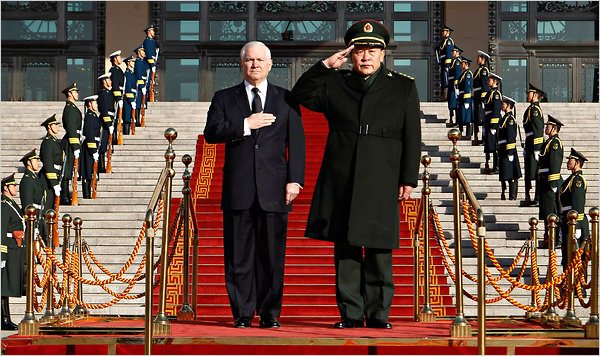By quietly building up its stash of high-tech weaponry, China is threatening US military supremacy in the Pacific, worrying its neighbors and contributing to a renewed arms race in Asia, analysts say.
Just days before Chinese President Hu Jintao’s visit to Washington and as US Defense Secretary Robert Gates was in Beijing this week to patch up frayed defense ties, China’s military sent its first stealth fighter into the skies.
Analysts agree the test flight of the J-20 carried out by the People’s Liberation Army (PLA), which surprised many military observers, was no coincidence.
“China is sending a strong message to the US and countries in the region that China’s military modernization is unstoppable, and China is determined to become this region’s dominant actor,” said Taiwan-based PLA expert Arthur Ding.
The emergence of the first photos of the J-20 just before Gates’ visit forced the Pentagon chief to admit that China “may be somewhat further along in the development of that aircraft than our intelligence had predicted”.
Analysts who have studied every pixel of these shots say while it is difficult to estimate just how advanced the plane — seen as an eventual rival to the US Air Force’s F-22A — really is, the message sent by Beijing is clear.
“While it does not truly demonstrate China’s capability in terms of developing the latest-technology military equipment, it certainly does demonstrate their ambition,” said Gareth Jennings, an aviation expert at Jane’s Missiles & Rockets magazine.
The PLA — the largest army in the world — is hugely secretive about its defense programs, which benefit from a big military budget boosted by the nation’s runaway economic growth.
Officially, China says its military technology is 20 to 30 years behind that of the United States, and maintains that the modernization of its army is purely defensive in nature.
But its neighbours are worried. Japan last month labeled Beijing’s military build-up a global “concern”, citing its increased assertiveness in the East and South China Seas.
Analysts say Beijing’s stated position no longer corresponds to the facts.
China, without formally acknowledging it, is building at least one aircraft carrier, which more than anything else will showcase its ability to project its military might further afield.
“They have equipment that is far from being defensive. More and more they have planes capable of striking ground targets,” a Western military expert based in Beijing, who refused to be named, told AFP.
“What is the use of that when you say you want to defend yourself?”
In 2007, China — a nuclear power — sparked international concern when it destroyed one of its satellites with a missile strike. And last January, the Chinese military intercepted an airborne missile.
Now, it is developing a ballistic missile capable of striking aircraft carriers — a move that threatens US supremacy in the Pacific.
Admiral Mike Mullen, head of the US Joint Chiefs of Staff, warned Wednesday that China’s new weapons programs, including the J-20, appeared to be directed against the United States.
Observers worry that the balance of power will shift in East Asia, where there are several potential sources of conflict revolving around Taiwan, North Korea and territorial disputes with neighboring states.
They say a new arms race seems inevitable.
“Today, nobody knows for sure how many J-20s the PLA will eventually deploy, nor how many ballistic missiles,” said Dennis Blasko, an expert on the PLA based in the United States.
“Neither can we predict the size and composition of US and allied forces beyond four or five years.”
Dean Cheng, a China expert at the Heritage Foundation, a US think tank, said there was “still time for the US to take corrective measures to hedge against these Chinese capabilities, both in its own arsenals and in what it provides Taiwan.”
The self-ruled island is a sore point in China-US military ties. Last year’s multi-billion-dollar arms deal between Washington and Taipei angered Beijing so much it suspended defense relations with the United States.
But for Rick Fisher of the International Assessment and Strategy Center, the United States and its allies “have a very short time frame to get really smart about the PLA’s intentions and technology directions”.
“If this cannot be done, for reasons of lack of information or lack of political will, Washington could soon find itself increasingly following China, and not leading the arms race,” Fisher said.










